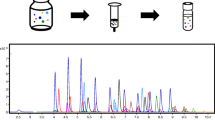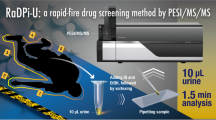Abstract
A quick screening method of more than 200 pharmaceutical and other residues in aquatic foods based on ultrahigh-performance liquid chromatography–quadrupole-Orbitrap mass spectrometry (UHPLC-Q/Orbitrap MS) was established. In this method, after the addition of 200 μL of 1 M EDTA-Na2, 2 g of each sample homogenate was extracted successively with 10 mL of acetonitrile and 10 mL of ethyl acetate. The extracts were combined, dried under nitrogen flow, and redissolved in 0.1% formic acid in acetonitrile/water (4:6, v/v) for analysis. The prepared samples were analyzed by UHPLC- Q/Orbitrap MS system in Full MS/ddMS2 (full-scan data-dependent MS/MS) mode. Compound identification was performed through comparison of the sample data with the database for standard chemicals, including the retention time, precursor ion, product ions, and isotope pattern for all 206 compounds. Five different aquatic food matrices (carp, shrimp, crab, eel, and mussel) spiked with the analytes at 1, 10, and 50 ng/g were evaluated to assess recoveries, precision, matrix effects, stability, and detection limits using the method. UHPLC analyses required 25 min, and 178–200 analytes met identification criteria at 50 ng/g depending on the matrix. Furthermore, practical application of this method for real samples displayed strong screening capability.

A quick screening method of >200 pharmaceutical and other residues in aquatic foods based on ultrahighperformance liquid chromatography–quadrupole-Orbitrap mass spectrometer was established. Fivedifferent aquatic food matrices, including carp, shrimp, crab, eel and mussel, were studied to evaluatescreen limit at 1, 10 and 50 μg·kg-1 level. Results suggest the high reliability, high time-efficiency and goodsimplicity of the method.







Similar content being viewed by others
References
Broughton EI, Walker DG. Policies and practices for aquaculture food safety in China. Food Policy. 2010;35(5):471–8.
Masiá A, Suarez-Varela MM, Llopis-Gonzalez A, Picó Y. Determination of pesticides and veterinary drug residues in food by liquid chromatography-mass spectrometry: a review. Anal Chim Acta. 2016;936(Supplement C):40–61.
Locatelli M, Sciascia F, Cifelli R, Malatesta L, Bruni P, Croce F. Analytical methods for the endocrine disruptor compounds determination in environmental water samples. J Chromatogr A. 2016;1434:1–18.
Gómez-Pérez ML, Romero-González R, Martínez Vidal JL, Garrido Frenich A. Analysis of veterinary drug and pesticide residues in animal feed by high-resolution mass spectrometry: comparison between time-of-flight and Orbitrap. Food Addit Contam Part A. 2015;32(10):1637–46.
Varol M, Sünbül MR. Organochlorine pesticide, antibiotic and heavy metal residues in mussel, crayfish and fish species from a reservoir on the Euphrates River, Turkey. Environ Pollut. 2017;230:311–9.
Guo J, Selby K, Boxall ABA. Assessment of the risks of mixtures of major use veterinary antibiotics in European surface waters. Environ Sci Technol. 2016;50(15):8282–9.
Anumol T, Lehotay SJ, Stevens J, Zweigenbaum J. Comparison of veterinary drug residue results in animal tissues by ultrahigh-performance liquid chromatography coupled to triple quadrupole or quadrupole–time-of-flight tandem mass spectrometry after different sample preparation methods, including use of a commercial lipid removal product. Anal Bioanal Chem. 2017;409(10):2639–53.
Baynes RE, Dedonder K, Kissell L, Mzyk D, Marmulak T, Smith G, et al. Health concerns and management of select veterinary drug residues. Food Chem Toxicol. 2016;88:112–22.
Wang Z, Beier RC, Shen J. Immunoassays for the detection of macrocyclic lactones in food matrices–a review. TrAC Trends Anal Chem. 2017;92:42–61.
Mainero Rocca L, Gentili A, Pérez-Fernández V, Tomai P. Veterinary drugs residues: a review of the latest analytical research on sample preparation and LC-MS based methods. Food Addit Contam Part A. 2017;34(5):766–84.
Zhang Y, Qiao H, Chen C, Wang Z, Xia X. Determination of nitrofurans metabolites residues in aquatic products by ultra-performance liquid chromatography–tandem mass spectrometry. Food Chem. 2016;192:612–7.
Lombardo-Agüí M, García-Campaña AM, Cruces-Blanco C, Gámiz-Gracia L. Determination of quinolones in fish by ultra-high performance liquid chromatography with fluorescence detection using QuEChERS as sample treatment. Food Control. 2015;50:864–8.
Zhu W-X, Yang J-Z, Wang Z-X, Wang C-J, Liu Y-F, Zhang L. Rapid determination of 88 veterinary drug residues in milk using automated TurborFlow online clean-up mode coupled to liquid chromatography-tandem mass spectrometry. Talanta. 2016;148:401–11.
Morris S, Allchin CR, Zegers BN, Haftka JJ, Boon JP, Belpaire C, et al. Distribution and fate of HBCD and TBBPA brominated flame retardants in North Sea estuaries and aquatic food webs. Environ Sci Technol. 2004;38(21):5497–504.
Nagata T, Saeki M. Simultaneous determination of thiamphenicol, florfenicol, and chloramphenicol residues in muscles of animals and cultured fish by liquid chromatography. J Liq Chromatogr Relat Technol. 1992;15(12):2045–56.
Zheng W, Park J-A, Zhang D, El-Aty AA, Kim S-K, Cho S-H, et al. Determination of fenobucarb residues in animal and aquatic food products using liquid chromatography-tandem mass spectrometry coupled with a QuEChERS extraction method. J Chromatogr B. 2017;1058:1–7.
Gan J, Lv L, Peng J, Li J, Xiong Z, Chen D, et al. Multi-residue method for the determination of organofluorine pesticides in fish tissue by liquid chromatography triple quadrupole tandem mass spectrometry. Food Chem. 2016;207:195–204.
Frenich AG, Romero-González R, del Mar Aguilera-Luiz M. Comprehensive analysis of toxics (pesticides, veterinary drugs and mycotoxins) in food by UHPLC-MS. TrAC Trends Anal Chem. 2014;63:158–69.
Dasenaki ME, Thomaidis NS. Multi-residue determination of 115 veterinary drugs and pharmaceutical residues in milk powder, butter, fish tissue and eggs using liquid chromatography–tandem mass spectrometry. Anal Chim Acta. 2015;880:103–21.
Turnipseed SB, Storey JM, Lohne JJ, Andersen WC, Burger R, Johnson AS, et al. Wide-scope screening method for multiclass veterinary drug residues in fish, shrimp, and eel using liquid chromatography–quadrupole high-resolution mass spectrometry. J Agric Food Chem. 2017;65(34):7252–67.
Mol HG, Zomer P, De Koning M. Qualitative aspects and validation of a screening method for pesticides in vegetables and fruits based on liquid chromatography coupled to full scan high resolution (Orbitrap) mass spectrometry. Anal Bioanal Chem. 2012;403(10):2891–908.
Núñez O, Gallart-Ayala H, Martins CPB, Lucci P. New trends in fast liquid chromatography for food and environmental analysis. J Chromatogr A. 2012;1228(Supplement C):298–323.
Wang J, Leung D, Chow W, Chang J, Wong JW. Development and validation of a multiclass method for analysis of veterinary drug residues in milk using ultrahigh performance liquid chromatography electrospray ionization quadrupole orbitrap mass spectrometry. J Agric Food Chem. 2015;63(41):9175–87.
Kaufmann A, Teale P. Capabilities and limitations of high-resolution mass spectrometry (HRMS): time-of-flight and Orbitrap™. In: Kay JF, MacNeil JD, Wang J, editors. Chemical analysis of non-antimicrobial veterinary drug residues in food. New York: Wiley; 2016. p. 93–139.
Cheng Q, Shou L, Chen C, Shi S, Zhou M. Application of ultra-high-performance liquid chromatography coupled with LTQ-Orbitrap mass spectrometry for identification, confirmation and quantitation of illegal adulterated weight-loss drugs in plant dietary supplements. J Chromatogr B. 2017;1064:92–9.
Williamson JC, Edwards AV, Verano-Braga T, Schwämmle V, Kjeldsen F, Jensen ON, et al. High-performance hybrid Orbitrap mass spectrometers for quantitative proteome analysis: observations and implications. Proteomics. 2016;16(6):907–14.
Turnipseed SB, Lohne JJ, Boison JO. Application of high resolution mass spectrometry to monitor veterinary drug residues in aquacultured products. J AOAC Int. 2015;98(3):550–8.
Dasenaki ME, Bletsou AA, Koulis GA, Thomaidis NS. Qualitative multiresidue screening method for 143 veterinary drugs and pharmaceuticals in milk and fish tissue using liquid chromatography quadrupole-time-of-flight mass spectrometry. J Agric Food Chem. 2015;63(18):4493–508.
Jia W, Chu X, Chang J, Wang PG, Chen Y, Zhang F. High-throughput untargeted screening of veterinary drug residues and metabolites in tilapia using high resolution orbitrap mass spectrometry. Anal Chim Acta. 2017;957:29–39.
Nácher-Mestre J, Serrano R, Portolés T, Berntssen MH, Pérez-Sánchez J, Hernández FL. Screening of pesticides and polycyclic aromatic hydrocarbons in feeds and fish tissues by gas chromatography coupled to high-resolution mass spectrometry using atmospheric pressure chemical ionization. J Agric Food Chem. 2014;62(10):2165–74.
Martinello M, Borin A, Stella R, Bovo D, Biancotto G, Gallina A, et al. Development and validation of a QuEChERS method coupled to liquid chromatography and high resolution mass spectrometry to determine pyrrolizidine and tropane alkaloids in honey. Food Chem. 2017;234:295–302.
European Commission Directorate-General for Health and Food Safety. SANTE/11945/2015:Guidance document on analytical quality control and method validation procedures for pesticides residues analysis in food and feed. Brussels, European Commission; 2015.
Rochat B. Proposed confidence scale and ID score in the identification of known-unknown compounds using high resolution MS data. J Am Soc Mass Spectrom. 2017;28(4):709–23.
Schymanski EL, Singer HP, Slobodnik J, Ipolyi IM, Oswald P, Krauss M, et al. Non-target screening with high-resolution mass spectrometry: critical review using a collaborative trial on water analysis. Anal Bioanal Chem. 2015;407(21):6237–55.
Gómez-Ramos M, Ferrer C, Malato O, Agüera A, Fernández-Alba A. Liquid chromatography-high-resolution mass spectrometry for pesticide residue analysis in fruit and vegetables: screening and quantitative studies. J Chromatogr A. 2013;1287:24–37.
Justino CI, Duarte KR, Freitas AC, Panteleitchouk TS, Duarte AC, Rocha-Santos TA. Contaminants in aquaculture: overview of analytical techniques for their determination. TrAC Trends Anal Chem. 2016;80:293–310.
Phu TM, Scippo M-L, Phuong NT, Tien CTK, Son CH, Dalsgaard A. Withdrawal time for sulfamethoxazole and trimethoprim following treatment of striped catfish (Pangasianodon hypophthalmus) and hybrid red tilapia (Oreochromis mossambicus× Oreochromis niloticus). Aquaculture. 2015;437:256–62.
Acknowledgments
The authors would like to acknowledge the financial support from the Shanghai Municipal Agricultural Commission, the Yangfan project (14YF1408100) from Science and Technology Commission of Shanghai Municipality – PR China and the special research fund for the national non-profit institutes (East China Sea Fisheries Research Institute) (No. 2014T05).
Author information
Authors and Affiliations
Corresponding authors
Ethics declarations
This research did not involve human participants or animals.
Conflict of interest
The authors declare that they have no conflict of interest.
Additional information
Published in the topical collection Food Safety Analysis with guest editor Steven J. Lehotay.
Electronic supplementary material
ESM 1
(PDF 3.29 MB)
Rights and permissions
About this article
Cite this article
Kong, C., Wang, Y., Huang, Y. et al. Multiclass screening of >200 pharmaceutical and other residues in aquatic foods by ultrahigh-performance liquid chromatography–quadrupole-Orbitrap mass spectrometry. Anal Bioanal Chem 410, 5545–5553 (2018). https://doi.org/10.1007/s00216-018-1124-5
Received:
Revised:
Accepted:
Published:
Issue Date:
DOI: https://doi.org/10.1007/s00216-018-1124-5




